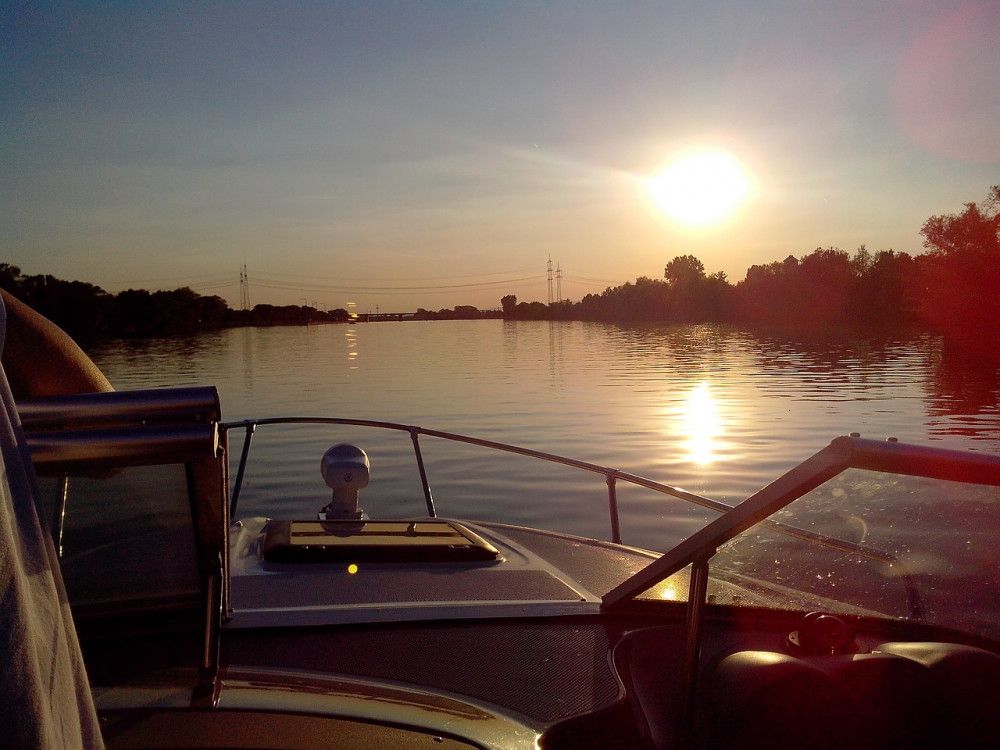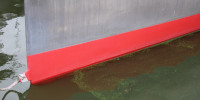How to Calculate Outboard Motor Size for Sailboats
It seems so complex to pick the right engine size for your sailboat. I was done with complex calculations and tried to make it easier here.
How to pick the right outboard motor size for your sailboat? To get the right amount of horsepower needed to efficiently propel a sailboat, divide the displacement of the boat (in lb) by 550. You need approximately 1 HP per 550 lb of displacement or 4 HP per 2200 lb. Most sailboats don't need a motor with more than 30 HP.
In this article, I'm talking about small outboard engines for sailboats. We're talking about displacement hulls here, so in other words: keel boats. They need more power than flat bottoms.
But they're not powerboats - so it's not our mission to go fast. It's our mission to get decent speed, good control over the boat, and the best possible fuel efficiency. Without breaking the bank of course.

On this page:
How To Pick The Right Motor Size
Sailboats need way smaller engines than powerboats. That's great news (unless your ultimate goal is speed), because it's cheaper to buy, cheaper to drive, and cheaper to maintain.
The amount of power you need is related to the hull displacement of your boat.
I like to use the simple formula:
HP = displacement (lb) / 550
So 1 HP for every 550 lb displacement, and 4 hp per 2200 lb.
Here, HP is the amount of horsepower you need to reach the maximum hull speed. This is in optimal conditions. So you have smooth water, no windage, a clean and polished hull, and so on.
If you want to get it absolutely right, you also need to correct for propellor size. And of course, a lot of other factors come into play (more on that later). But generally, these engine sizes will work with the following weights:
| Weight | HPs | Typical boat length |
|---|---|---|
| 1,000 lb | 1-2 HP | 18' |
| 2,000 lb | 4 HP | 20' |
| 3,000 lb | 6 HP | 22' |
| 4,000 lb | 8 HP | 24' |
| 5,000 lb | 9 HP | 26' |
| 6,000 lb | 11 HP | 26' |
| 7,000 lb | 13 HP | 27' |
| 8,000 lb | 15 HP | 28' |
| 10,000 lb | 18 HP | 30' |
| 12,000 lb | 22 HP | 32' |
| 15,000 lb | 28 HP | 36' |
| 18,000 lb | 34 HP | 40' |
That sounds about right to me. But remember that these are all rough estimates: I just try to give you a ballpark figure. There is no one formula to get an exact number. The hull design, sailing conditions, and your personal preference are all very important.
If you're serious about getting a new engine, I definitely recommend to get advice from an expert. But you know, salespeople always recommend the Turbo version. Remember that you don't have to overpower a sailboat. Usually you don't need anything over 30 HP. So at least you now know what will work on average.
What is hull displacement?
- Hull displacement is the weight of the boat, or the amount of water the boat displaces.
- Maximum hull displacement is the weight of the boat when it's fully loaded, including crew.
The weight of the boat is the same as its displacement, because the weight of any object is exactly equal to the weight of the water it displaces (aka: pushes aside). This is called Archimedes Principle.
The weight slightly differs in saltwater from freshwater, because saltwater is heavier. In saltwater, the boat gets a bit lighter. So in theory you can use a smaller engine for a bluewater boat, but in practice this is offset by the stronger current and wind.
How to find the displacement of your boat?
Most manufacturers simply give you the displacement of your boat. If you can't find any data, because, for example, you own an old boat, you can weigh your boat on a truck scale. You can also haul it out and measure it (which is painstaking work).**
Tip: if you're gonna weigh your boat, simply drive it onto a truck scale, and retract the weight of the trailer from the total weight.
Other Factors That Are Important for Size
Of course, it's not so simple. This formula gives a rough estimate. But for me this was way clearer than all that black magic that I get when I ask people what size engine I should get.
Let's look at the things this formula doesn't take into account.
| You need more HPs | You need less HPs |
|---|---|
| 4-stroke engine | 2-stroke engine |
| smaller propellor | larger propellor |
| gas (less torque) | diesel (more torque) |
| multihull (high windage) | monohull |
| long distances or against wind | just in and out marina |
| bluewater sailing | lakes and inland sailing |
| wooden boat | fiberglass boat |
2-strokes are more powerful than 4-strokes. Two-stroke engines fire once every revolution and four-strokes fire once every other revolution. This makes the 2-stroke twice as powerful. They provide more torque at a higher RPM. But they also wear more quickly. The 4-stroke will last you a lot longer, and its also more fuel efficient.
The right propellor size is just as important as having enough horsepower. With a smaller prop diameter, it has to work harder to generate the same propulsion as a larger diameter. But you can't just go larger always. The prop affects the RPM of your engine, and you have to get in the right range (more on this later). You also have to check the maximum diameter that fits your boat.
Diesels have more torque, because the compression rate is higher than that of gasoline engines. So if you consider a diesel, you can do with less HPs.
High windage hulls (multihulls) need a bit more. A multihull (or larger hull in general) suffers from more friction because of the larger surface. So the engine needs to work a little harder.
If you sail longer distances under power, or against the wind it's a good idea to get a larger engine (but not too large). This helps you to save on fuel since you have lower RPM. Especially if you sail offshore or on open sea. The engine needs to work harder due to stronger wind and current.
If you're just sailing in and out of the marina under power, you may need less HP.
Smooth hull designs need less HPs than bulky hull designs, like the classic wooden clippers and crabbers for example.
Why is the Right Motor Size Important?
It matters to get the right size outboard motor for a couple of reasons.
First of all: smaller engines are cheaper, so you save money on buying the engine.
Secondly: smaller engines use a lot less fuel, so you save money on using the engine.
Thirdly: smaller engines are cheaper to maintain: so you save money on maintenance.
So why not get the smallest engine and get the best fuel economy? There are a couple of advantages to getting a (slightly) bigger engine:
- More power means more control (easier to stop the boat, in case you need to)
- Finding the sweet spot might actually reduce fuel consumption
The sweet spot
To perform optimally, an engine should get up to speed. The problem with an overpowered boat is that the engine won't rev up to 80 - 90% of the RPM. This kills fuel efficiency and also the cooling system won't operate optimally.
- The optimal cruising RPM of the engine is about 85-95% of the maximal RPM
- You should reach cruising RPM at hull speed, so your engine should be at about 90% RPM
The propeller size is very important for the RPM. If your prop diameter is too wide, the engine can't get up to speed and struggles to build power. Bad for fuel economy, bad for the engine, and bad for performance.
On the other hand, if your prop is too small, you don't make use of the engine's full power.
If you struggle to get to high RPM, your prop is too large. If your engine is constantly in the red, you're underpropped.
So don't go too big on the prop, but also don't go too small. The easiest way to get it right is to check the engines manual and see what the manufacturer recommends.
Is There a Max HP for Sailboats?
You can definitely go too big on a sailboats engine. An overpowered yacht doesn't make any sense. True, it can look cool, but it can't feel cool. Every displacement hull has a maximum hull speed. That means that it cannot go any faster than the max speed. So if your engine can cruise at that speed, it's not getting any better.
The problem with displacement hulls is that they displace the water, or in other words: they push the water in front of them. They cannot move any faster than they can push away the water. And because the resistance increases as speed increases, there's an absolute, physical speed limit for each keelboat.
That's why powerboats have to get out of the water to reach top speed.
Fun fact: the longer your boat, the higher the hull speed. Want to know the maximum hull speed for your boat? You can find it in this article.
So, you can't go faster than your maximum hull speed, so a 50+HP engine is kind of ridiculous. Bear in mind that a large engine also has the following disadvantages:
First of all: larger engines are more expensive, so you spend more money when buying the engine.
Secondly: larger engines use a lot more fuel, so you spend more money when using the engine.
Thirdly: larger engines are more expensive to maintain: so you spend more money on maintenance.
Also, if your engine is too big, it doesn't reach the optimal cruising RPM, so your fuel economy also gets really bad FAST.
In Conclusion
I suggest getting the smallest possible engine that gets you to maximum hull speed while it's at roughly 90% of the RPM. As long as it gives you enough control and good handling, it will get you there. If you give up on going fast, you can actually get really good fuel economy and your engine will last you probably 20 years.
If you want to go fast, a sailboat is not the right one for you. You should instead get a powerboat.
I'm just kidding. Read my 13 Reasons Why Sailing is Better Than Powerboating here.
Related Questions
Do sailboats have motors? Most sailboats are power assisted boats, which means they have a small auxiliary engine to cruise in light air. When a sailboat is sailing under engine power, it is considered a motorboat and it doesn't have right of way.
Did you find the answer to your specific question?
👍 36 👎 4



Comments
MitI
Thanks for answering my questions.
Taylor Bishop
Thanks for explaining how you can figure out what size you need for an outboard motor. You mentioned that you should find the displacement by weigh a boat on a truck scale. I’m interesting to learn if you need to regularly weigh it in case the hull displacement could change or if it will always be consistent.
Shawn Buckles
Hi MitI, you’re welcome, my pleasure.
Shawn Buckles
Hi Taylor, my pleasure.
You don’t need to weigh your boat regularly, as the hull displacement will stay consistent. You could literally see the hull displacement as the amount of space your hull takes up in the water. So as long as you don’t make any major changes to the hull shape or ballast of your boat, you should see no differences in displacement.
Roger S Johnson
How do you measure for shaft size, most outboard motors are for flat bottom and say measure to the bottom of the boat, most sailboats tapper to the aft. Where do you measure for a tapered bottom sail boat?
Thanks,
Luke
Will a 5 horse Honda 4 stroke be ok for a 25 foot Pearson Commander sail boat. Thanks for your time Luke
Shawn
I think it would be Luke.
Pete
Hi Shawn,
Great post, thanks for the info. A naive question from a soon-to-be sailor: I’m considering buying a 28 ft sailboat, with 2500 kg (ca. 5500 lbs) displacement. The engine is in pretty good condition, but is old and the original one (from 1977!), so I am also thinking of an alternative scenario in which it fails. I know that in my area replacing an inboard engine will cost double the price I’m putting down for the boat, and since I’m on a budget, that simply won’t be an option and outboards seem to be cheaper. So the question is: is it possible to put an outboard engine on all boats? Is there some factor that would make it impossible to mount an outboard engine on the boat? Thanks!
Garth Powelson
What is minimum length that a sailboat can go without an outboard. Does a 29’ “require by law” to have engine?
Shipwreck
Hello Mr. Buckles,
Thanks for the informative article.
I’m looking to get the smallest possible outboard for my 1.5 ton displacement fiberglass monohull Hood 23’ sloop.
Can I get away with a 4HP?!?
What size prop would I need?!?
(I’m only going to use it when there is NO wind, and, if I can stay 4HP or below, I am not required to register my vessel—which is pretty cool, so here’s hoping!)
Thanks again,
Ship
Phil
Hi,
I’ve got a older Pearson 39’ . I’m looking to remove the old 40 ho westerbeke and go electric. Unsure of what hp is going to be needed?
emilio h javier
i am purchasing a catalina 22 ft. i have in mind a 4 HP motor.
what would be the length of the shaft.
Rick
I am considering buying a 25 ft sailboat with a 7200 lb displacement. The boats top speed is listed at 7knots per hour but the diesel motor does not work. The owner has a 9.9hp outboard that can be purchased with the boat. Is 9.9hp enough to power the boat to at least 5 to 6 knots per hour?
Thanks.
Rick
Paul
What weight outboard would be too much for a 20’ Santana, displacement 1,350 lbs? I don’t want too much weight at the back. I want the boat to be seaworthy.
Ansset
I have not seen this amount of BS in years :)
I’m not a marine engineer, yet physicist & avation engineer. You even can’t tell the difference between mass of the vessel and diplacement :D
Fcking genius.
Leave a comment